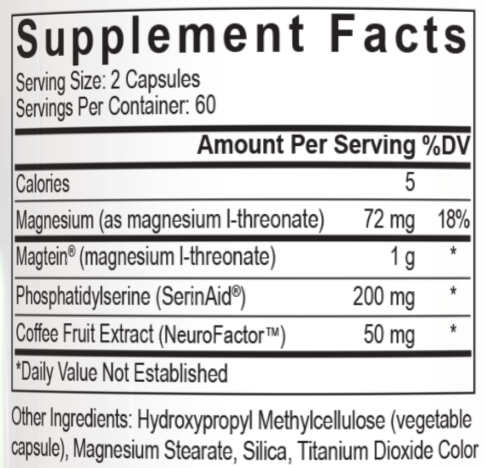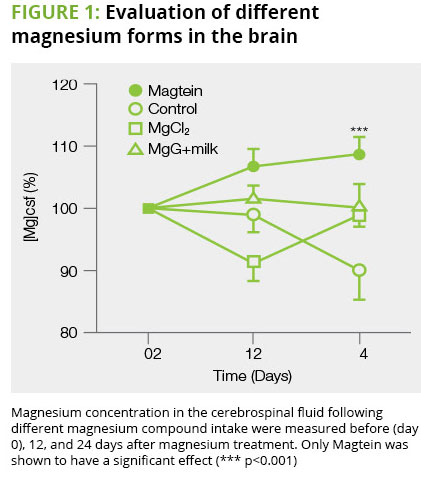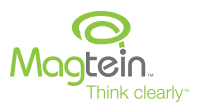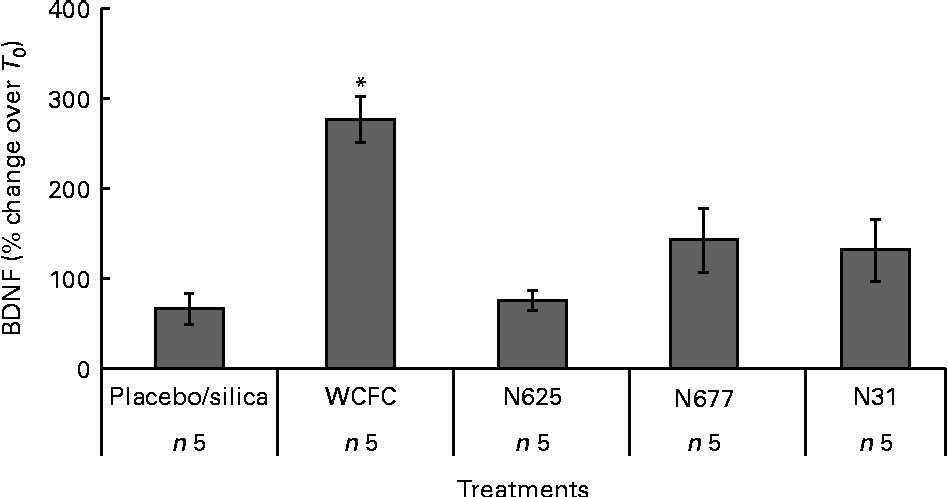2020 Notice: This supplement has unfortunately been discontinued. We are leaving this post up because the formula is interesting, especially the research on Magtein. You will need to find these ingredients elsewhere, however.
2024 Update: Another supplement has been launched by PEScience under the same name, but with a different formula. It contains just 100mg phosphatidylserine per softgel.
Do you find that aging hasn't been kind to your brain? PEScience answered your plea for help with a new product in its "Tru" Line, TruNeuro, but its only here for a limited time (unless all of us Gen-X'ers and Boomers buy it up like crazy!)
PEScience targets their needs

As you age, your brain ages even more. TruNeuro was designed to prevent the decline with three amazingly-dosed ingredients that can be taken "forever".
2018 has been a good year for PEScience. The uber-soft Select Protein Bars can hardly stay in stock, and Symbiont-GI was a most unique industry development that nudged the brand away from sports nutrition, but it was something they developed for personally "selfish" reasons.
It looks like their innovation train is still running - and once again, we have one that's not meant for the typical "18-34 year old bros" that the company was founded on. Instead, this is a cognitive supplement that will work best for those beyond that age:
Introducing TruNeuro, a limited-time exclusive nootropic
PEScience has developed a new cognitive-enhancing supplement based in neuroprotection and anti-aging, and it's one that can be taken every day for a long time. While the product is a limited run, it is another sign that the company is seeking to expand outside of its traditional boundaries... and if they have more "wiser" customer than they realize, they could turn this into a full-blown product launch.
TruNeuro relies on just three trademarked ingredients, and one of them is fascinating... but not cheap. The label may confuse our nootropic obsessed followers as there are no "traditional" nootropic ingredients present in TruNeuro. However, we must keep the purpose of this product in mind. They developed TruNeuro to maintain brain health as we age, not to make our minds run like a short-distance bullet train.
We want ingredients that optimize our natural functioning. So let's show the prices (or sign up for alerts if not in stock) and then hit up that ingredient list!
PEScience TruNeuro – Deals and Price Drop Alerts
Get Price Alerts
No spam, no scams.
Disclosure: PricePlow relies on pricing from stores with which we have a business relationship. We work hard to keep pricing current, but you may find a better offer.
Posts are sponsored in part by the retailers and/or brands listed on this page.
The TruNeuro Ingredients
Note: The following ingredient doses are based upon an entire day's supply (four total capsules), but it's meant to be taken twice per day, two capsules at a time. So we've doubled what's on the label to show you your final daily values. This yields a 30 day supply.
What you'll notice here are three ingredients that can be used every day, forever. We'll get into that after the analysis:
-
Magtein (magnesium l-threonate) (2g)
Note that this is half of your day's supply, so you're getting clinical and some above clinical doses here!
Magtein, or magnesium l-threonate, is a trademarked matrix of magnesium and l-threonate. This is the only known form of magnesium able to cross the blood-brain barrier.[1]
So we don't want you to look at the daily value here, which will cover 36% of your recommended magnesium intake (a huge boost). Instead, focus on the data showing that magnesium l-threonate may be the only form of magnesium that can raise the amount of magnesium in the brain itself![2]
The premise is that researchers have found that the level of brain magnesium is a critical factor controlling synapse density and plasticity,[3] but magnesium levels in the brain fall as we age.[4] This is why we say that this is a nootropic that's really only probably worth it to those 35 and over (or feeling 35 and older!), as this ingredient is expensive and younger users just won't get as much bang for buck.
Anyway, to compensate for said brain-based magnesium-loss, PEScience includes Magtein in TruNeuro.
Is Magtein for real?
Seems very much like it -- the research on magtein is superb. One investigation found that magtein supplementation may improve synaptic density and cognitive functioning in older adults.[3] Magtein also may restore neuronal inflammation-based memory loss.[5] It's so promising that the National Institutes of Health (NIH) is hopping on board to see if it will benefit those that suffer from major neurodegenerative diseases.
It's well-known that there is a correlation between rates of brain atrophy and cognitive decline,[6,7] and the best structural indicator of that which we can see is the degree of synaptic loss.[8] If you can improve the magnesium uptake, and increase synaptic density, you have something seriously important here. This is why Magtein is shaping up to be a big deal, and PEScience clearly wants to keep some of that brain matter in house.
However, cost can be an issue. Magtein is a trademarked form of magnesium, and it's supported in human trials - never cheap. Those two facts mean that the cost will rise.
Is it worth the money? Looking at the data... we think it might be -- for the right person.
Note: You may also see this as L-Threonic acid Magnesium salt, or L-TAMS, formerly known as MgT.[3]
-
Phosphatidylserine (SerinAid) (400mg)
To start off... 400mg is a ton of phosphatidylserine! And PEScience states that this is the resultant amount of "PS" you're getting (note that the silica it's typically bound with is found in the "Other Ingredients" area), as they're using the 70% active form of SerinAid (we more commonly see 10% or 50%). Made by Chemi Nutra, this is the gold standard of phosphatidylserine (PS).
PS does more than just enhance cognitive function. Here's a simple chart showing that golfers hit balls better with higher doses of PS.
So right away this made our jaws drop and further props the price up. But the benefits are now clinical:
PS is a fat soluble amino acid found in the brain naturally. Supplementing the ingredient aids cognitive function and improves mood. For TruNeuro, it does so while slowing cognitive decline in the elderly.[9] It will also help you mitigate the negative health impact of chronic stress.[10]
But it gets better, thanks to the dose! For the improvement of cognition and memory as well as the prevention of cognitive decline, 400mg/day is at or above clinical human dosing![11-13] A couple studies worked well at 300mg, but PEScience clearly isn't messing around with this one, and the price tag will reflect that.
-
Coffee Fruit Extract (NeuroFactor) (100mg)
NeuroFactor is a trademarked coffee bean extract developed by FutureCeuticals, a company we've grown to respect. The research on NeuroFactor is promising, with studies suggesting that it may acutely raise levels of brain-derived neurotrophic factor by 144%.[14,15]
Blood levels of brain-derived neurotrophic factor (BDNF) collected from subjects treated with whole coffee fruit concentrate powder (WCFC), green coffee bean extract powder (N625), green coffee caffeine powder (N677), grape seed extract powder (N31) and placebo (silica).
Brain-derived neurotrophic factor, or BDNF, plays a role in neurogenesis and neuronal repair. It also may be preventative and help slow neuronal decay.[16] In theory, more BDNF means more learning, metabolism, better moods, and better overall well-being.
Once again, we are at clinical dosing -- 100mg/day is where the aforementioned study was dosed.[14,15]
What? Where's the "regular" stuff?!
Wait, no choline?! But it seems like PEScience loves their citicoline, so why not put it in here?
We asked that question and they generally answered: Because high doses of choline are for acute uses - perhaps weeks or even months at a time at most -- but according to the brand, if you take too much for too long, you'll eventually experience side effects.
The same goes for Huperzine A, another common cognitive-enhancing ingredient that plays "defense". We love to temporarily use it to dampen the effects of acetylcholinesterase to keep acetylcholine around longer for a workout or a study session, but do that all day every day and you're asking for headaches.
A forever supplement here
TruNeuro was meant for long-term use, and it's meant to supplement whatever else you may be acutely cycling in at the time. This is the nootropic that has what other general "feel-good" nootropics don't typically bother with, and that's why it will fit in nearly any stack.
So the question remains - if it's meant to be taken forever, why only tease a limited-time release? The answer is -- because they made it for themselves first and foremost, but if everyone does want to get in on it and its hefty price tag, then maybe they'll keep it around or make it in spurts.
PEScience changes with age, and they're bringing their brains with them
PEScience has been around for a while, and it's clear that they're allowing themselves to "age gracefully" out of the "hardcore" bodybuilding and sports nutrition space they started in. The additions of Vegan Select Protein, Symbiont-GI, and reformulations of Alphamine were indicative of that, and TruNeuro is even more so.
We love it when a company's okay with aging its product lines along with its original customer base -- and its employees. There will always be a new batch of 25 year olds to come and take the bodybuilding helm, but it's nice to see an intelligently-run company with clean formulas that's catering to the space in the middle of "elderly" and "20 year old bro".

Aging with grace and class, and putting out amazing formulas for all kinds of people! See our coupons to save on PricePlow.com/pescience
So as close followers of PEScience, we're selfishly happy to see them growing alongside us.
TruNeuro focuses on neuronal protection only and pulls it off with just three amazing ingredients at incredibly solid, yet expensive dosages. If you're in that middle-aged bracket, love nootropics, and have a solid bit of bonus cash, we are all for you copping a bottle of the initial run to encourage the crew at PEScience to continue producing such novel products. They're not the only ones who need them.
PEScience TruNeuro – Deals and Price Drop Alerts
Get Price Alerts
No spam, no scams.
Disclosure: PricePlow relies on pricing from stores with which we have a business relationship. We work hard to keep pricing current, but you may find a better offer.
Posts are sponsored in part by the retailers and/or brands listed on this page.
References:
- Slutsky, I., Abumaria, N., Wu, L., Huang, C., Zhang, L., Li, B., . . . Liu, G. (2010). Enhancement of Learning and Memory by Elevating Brain Magnesium. Neuron, 65(2), 165-177; https://www.drperlmutter.com/wp-content/uploads/2015/01/MagT-Nureon-article-2010.pdf
- Magnesium L-Threonate to Enhance Learning and Memory in People with Dementia. (n.d.); https://www.nia.nih.gov/alzheimers/clinical-trials/magnesium-l-threonate-enhance-learning-and-memory-people-dementia
- Liu, G., Weinger, J. G., Lu, Z., Xue, F., & Sadeghpour, S. (2015). Efficacy and Safety of MMFS-01, a Synapse Density Enhancer, for Treating Cognitive Impairment in Older Adults: A Randomized, Double-Blind, Placebo-Controlled Trial. Journal of Alzheimers Disease, 49(4), 971-990; https://content.iospress.com/articles/journal-of-alzheimers-disease/jad150538
- Killilea, D. W., & Maier, J. A. M. (2008). A connection between magnesium deficiency and aging: new insights from cellular studies. Magnesium Research : Official Organ of the International Society for the Development of Research on Magnesium, 21(2), 77–82; https://www.ncbi.nlm.nih.gov/pmc/articles/PMC2790427/
- Wang J, Liu Y, Zhou LJ, et al. Magnesium L-threonate prevents and restores memory deficits associated with neuropathic pain by inhibition of TNF-α. Pain physician. ; 16(5):E563-75; https://pubmed.ncbi.nlm.nih.gov/24077207
- Jack CR Jr , Wiste HJ , Weigand SD , Knopman DS , Vemuri P , Mielke MM , Lowe V , Senjem ML , Gunter JL , Machulda MM , Gregg BE , Pankratz VS , Rocca WA , Petersen RC; Age, sex, and APOE epsilon4 effects on memory, brain structure, and beta-amyloid across the adult life span. JAMA Neurol 72, 511–519; 2015; https://www.ncbi.nlm.nih.gov/pmc/articles/PMC4428984/
- Fox NC , Scahill RI , Crum WR , Rossor MN; Correlation between rates of brain atrophy and cognitive decline in AD; Neurology 52, 1687–1689; 1999; https://n.neurology.org/content/52/8/1687
- Terry RD , Masliah E , Salmon DP , Butters N , DeTeresa R , Hill R , Hansen LA , Katzman R; "Physical basis of cognitive alterations in Alzheimer's disease: Synapse loss is the major correlate of cognitive impairment"; Ann Neurol 30, 572–580; 1991; https://onlinelibrary.wiley.com/doi/abs/10.1002/ana.410300410https://onlinelibrary.wiley.com/doi/abs/10.1002/ana.410300410
- Kataoka-Kato A, Ukai M, Sakai M, Kudo S, Kameyama T. Enhanced learning of normal adult rodents by repeated oral administration of soybean transphosphatidylated phosphatidylserine. Journal of pharmacological sciences. 2005; 98(3):307-14; https://pubmed.ncbi.nlm.nih.gov/16006737
- Baumeister J, Barthel T, Geiss KR, Weiss M. Influence of phosphatidylserine on cognitive performance and cortical activity after induced stress. Nutritional neuroscience. 2008; 11(3):103-10; https://pubmed.ncbi.nlm.nih.gov/18616866
- Vakhapova, V, et al; "Phosphatidylserine containing omega-3 fatty acids may improve memory abilities in non-demented elderly with memory complaints: a double-blind placebo-controlled trial"; Dement Geriatr Cogn Disord; 2010; 29(5):467-74; https://pubmed.ncbi.nlm.nih.gov/20523044
- Parker, Adam G et al; "The Effects of IQPLUS Focus on Cognitive Function, Mood and Endocrine Response before and Following Acute Exercise"; Journal of the International Society of Sports Nutrition; 8 (2011): 16; https://www.ncbi.nlm.nih.gov/pmc/articles/PMC3210081/
- Kato-Kataoka, Akito et al; "Soybean-Derived Phosphatidylserine Improves Memory Function of the Elderly Japanese Subjects with Memory Complaints"; Journal of Clinical Biochemistry and Nutrition; 47.3 (2010): 246–255; https://www.ncbi.nlm.nih.gov/pmc/articles/PMC2966935/
- Reyes-Izquierdo, T., Nemzer, B., Shu, C., et al; "Modulatory effects of coffee fruit extract on plasma levels of brain-derived neurotrophic factor in healthy subjects"; British Journal of Nutrition; 2013; https://www.cambridge.org/core/journals/british-journal-of-nutrition/article/modulatory-effect-of-coffee-fruit-extract-on-plasma-levels-of-brain-derived-neurotrophic-factor-in-healthy-subjects/8B291E8D053143AA5A8D33B65496B034/core-reader
- Futureceuticals; "NeuroFactor Increases Plasma Levels of BDNF in Humans"; 2012; https://docdro.id/kJEfIt7
- NCBI Gene; "BDNF brain derived neurotrophic factor [ Homo sapiens (human)"; https://www.ncbi.nlm.nih.gov/gene/627








Comments and Discussion (Powered by the PricePlow Forum)